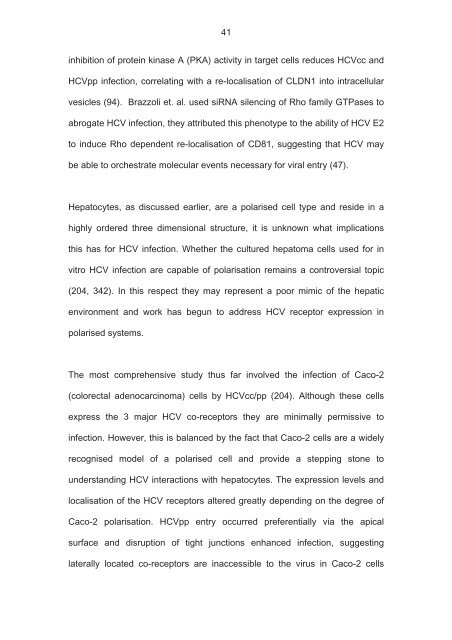The role of scavenger receptor BI in hepatitis - eTheses Repository ...
The role of scavenger receptor BI in hepatitis - eTheses Repository ...
The role of scavenger receptor BI in hepatitis - eTheses Repository ...
Create successful ePaper yourself
Turn your PDF publications into a flip-book with our unique Google optimized e-Paper software.
41<br />
<strong>in</strong>hibition <strong>of</strong> prote<strong>in</strong> k<strong>in</strong>ase A (PKA) activity <strong>in</strong> target cells reduces HCVcc and<br />
HCVpp <strong>in</strong>fection, correlat<strong>in</strong>g with a re-localisation <strong>of</strong> CLDN1 <strong>in</strong>to <strong>in</strong>tracellular<br />
vesicles (94). Brazzoli et. al. used siRNA silenc<strong>in</strong>g <strong>of</strong> Rho family GTPases to<br />
abrogate HCV <strong>in</strong>fection, they attributed this phenotype to the ability <strong>of</strong> HCV E2<br />
to <strong>in</strong>duce Rho dependent re-localisation <strong>of</strong> CD81, suggest<strong>in</strong>g that HCV may<br />
be able to orchestrate molecular events necessary for viral entry (47).<br />
Hepatocytes, as discussed earlier, are a polarised cell type and reside <strong>in</strong> a<br />
highly ordered three dimensional structure, it is unknown what implications<br />
this has for HCV <strong>in</strong>fection. Whether the cultured hepatoma cells used for <strong>in</strong><br />
vitro HCV <strong>in</strong>fection are capable <strong>of</strong> polarisation rema<strong>in</strong>s a controversial topic<br />
(204, 342). In this respect they may represent a poor mimic <strong>of</strong> the hepatic<br />
environment and work has begun to address HCV <strong>receptor</strong> expression <strong>in</strong><br />
polarised systems.<br />
<strong>The</strong> most comprehensive study thus far <strong>in</strong>volved the <strong>in</strong>fection <strong>of</strong> Caco-2<br />
(colorectal adenocarc<strong>in</strong>oma) cells by HCVcc/pp (204). Although these cells<br />
express the 3 major HCV co-<strong>receptor</strong>s they are m<strong>in</strong>imally permissive to<br />
<strong>in</strong>fection. However, this is balanced by the fact that Caco-2 cells are a widely<br />
recognised model <strong>of</strong> a polarised cell and provide a stepp<strong>in</strong>g stone to<br />
understand<strong>in</strong>g HCV <strong>in</strong>teractions with hepatocytes. <strong>The</strong> expression levels and<br />
localisation <strong>of</strong> the HCV <strong>receptor</strong>s altered greatly depend<strong>in</strong>g on the degree <strong>of</strong><br />
Caco-2 polarisation. HCVpp entry occurred preferentially via the apical<br />
surface and disruption <strong>of</strong> tight junctions enhanced <strong>in</strong>fection, suggest<strong>in</strong>g<br />
laterally located co-<strong>receptor</strong>s are <strong>in</strong>accessible to the virus <strong>in</strong> Caco-2 cells

















